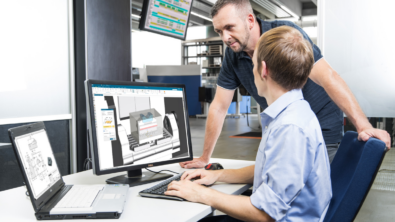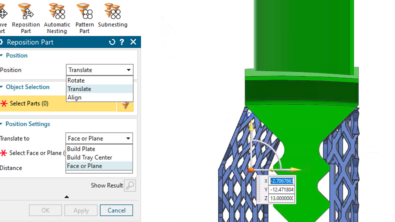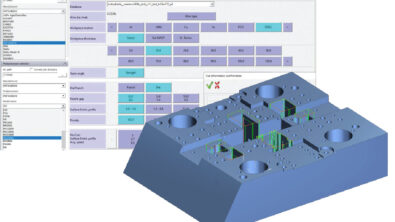Additive Manufacturing Technology + Automotive Industry = Modernization

Rubber hits the road
I have a confession to make. I am in love. With a car. Interestingly, it was my mother who instilled a love of the automobile into my brother and me. She drove a ragtop MG when she was young and it sparked a love of roadsters and sportscars that exists in her to this day. My brother and I inherited her passion and we bedecked the walls of our boyhood room with posters of Lambroghini Countaches and Ferrari Testarossas. (It was the 80’s after all…)Later, when my wife and I finally sent our kids off into the big world to live on their own, I decided it was time to get a weekend car. My garage is currently home to a 30-year-old classic that I have definitely spent more money fixing up than the car is actually worth.
Parts made of “unobtainum”
Classic car owners like myself are occasionally bedeviled by the inability to find proper replacement parts for our vehicles. Original equipment manufacturer (OEM) parts sometimes no longer exist because the stock was exhausted years ago, and new stock replacements are not always available.
 Therefore, it was with some interest that I saw an article cross my desk talking about how a major manufacturer of luxury sports cars was using additive manufacturing technology to print replacement parts for some of their rarer classic cars. Now, the cars in question were very rare indeed, costing upwards of $1.5 million at recent auctions. However, on-demand replacement parts is one of the additive manufacturing use cases we commonly talk about here at Siemens, so we expect to see more auto manufacturers adopting 3D printing for replacement parts as time goes on and as the prices of 3D printed parts come down. In the meantime, it is fun to think of these old classics being given a new lease on life using modern additive manufacturing processes.
Therefore, it was with some interest that I saw an article cross my desk talking about how a major manufacturer of luxury sports cars was using additive manufacturing technology to print replacement parts for some of their rarer classic cars. Now, the cars in question were very rare indeed, costing upwards of $1.5 million at recent auctions. However, on-demand replacement parts is one of the additive manufacturing use cases we commonly talk about here at Siemens, so we expect to see more auto manufacturers adopting 3D printing for replacement parts as time goes on and as the prices of 3D printed parts come down. In the meantime, it is fun to think of these old classics being given a new lease on life using modern additive manufacturing processes.
When this baby hits 88 miles per hour…
 The original bracket on the left and the topology optimized bracket on the right.We have also been working with the Formula Student Rennstall team from Esslingen, Germany. This team of students fields two formula racing cars that they use as educational vehicles for their students. Being racecars, the goal is of course to get as much speed as possible from the package within the given rules and parameters. One way to achieve new extremes in land speed is to reduce the weight of the automobile, and with a racecar, every ounce counts.
The original bracket on the left and the topology optimized bracket on the right.We have also been working with the Formula Student Rennstall team from Esslingen, Germany. This team of students fields two formula racing cars that they use as educational vehicles for their students. Being racecars, the goal is of course to get as much speed as possible from the package within the given rules and parameters. One way to achieve new extremes in land speed is to reduce the weight of the automobile, and with a racecar, every ounce counts.
Traditionally, this would be done by using lightweight materials and removing any unnecessary structural items. However, once you have exhausted the traditional methods for reducing the weight of your vehicle, you can now look to additive manufacturing for further optimization. This is why the Formula Student Rennstall team is working with Siemens to use our topology optimization software and additive manufacturing technology to create structurally sound components with minimal weight. These components replace the heavier components that were manufactured using traditional methods, giving the team every advantage possible and educating the next generation of engineers in the process.
It is only a matter of time before manufacturers of standard cars and trucks begin looking to additive manufacturing technology to solve their efficiency problems as well. Some automakers are already replacing spare tires with run-flat tires or cans of tire repair sealant to reduce weight. With increasing fuel standards, the need for reducing the weight of every automobile manufactured will only get stronger and with that, the viability of using additive manufacturing to solve some of those problems.
Accelerating from a dead stop
These may be extreme examples of use cases for additive manufacturing in the automotive industry, but in fact, this is often how the automotive world works. New systems and parts are often proven on very high-end cars like supercars and racecars before they filter down to the everyday drivers we all know and love. While these 3D printed parts might be currently produced for rare classic cars and racecars, it is only a matter of time before we start seeing 3D printed replacement parts and even first run components on the cars we drive every day. At Siemens, we have been promoting and showing examples of how additive manufacturing technology can be used in the automotive industry for years, and we are working with our friends in the automotive industry to make that vision a reality.
I would love to hear how you envision additive manufacturing being used to modernize the automotive industry. Leave a comment below and join the discussion.
This is part two of a five-part series on additive manufacturing technology innovation in various industries.
Ashley Eckhoff has a background in engineering and has been with Siemens for over 20 years in various capacities. He has spent the last few years deep-diving into additive manufacturing in both product design and marketing roles.


